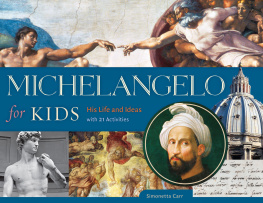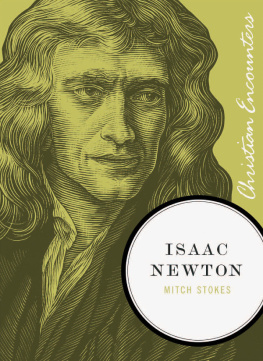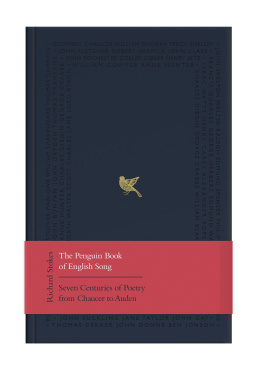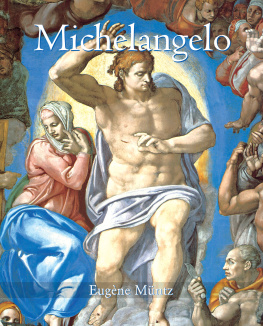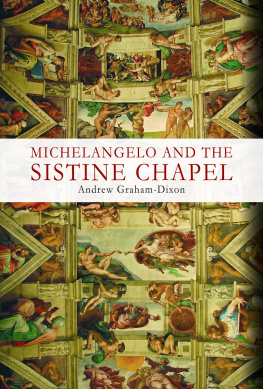
Michelangelo
Because a sculptors work is so slow there is not so much time to read serious books really thoroughly, but this is one I hope to read at least once, if not twice, more. I think Adrian Stokes has made a new, deep and penetrating contribution to present-day art criticism.
Henry Moore
No one else has so pondered the implications of the fact that a capacity to understand art is dependent on a capacity to understand human beings. Michelangelos artistic personality has been profoundly read. It will be difficult to be content again with any view that does not look into its depth, or with one which does not see the mans life, his visual works and his poetry together.
Lawrence Gowing
Adrian Stokes (is) a critic whose work is not as well known as it should be Michelangelo is not a long book, but it is so tightly packed with meaning that it must be read more than once I myself have read it three times, and with each reading have found increased understanding and pleasure.
Herbert Read
this book is one of the few written by an art critic in which the processes underlying artistic creation are described with deep psychoanalytical insight.
H. Sydney Klein, International Journal of Psychoanalysis
Adrian
Stokes
Michelangelo
A Study in the Nature of Art
With a new introduction by Richard Wollheim

First published 1955 by Tavistock Publications Limited
First published in Routledge Classics 2002 by Routledge
2 Park Square, Milton Park, Abingdon, Oxon OX14 4RN
Simultaneously published in the USA and Canada
by Routledge
711 Third Avenue, New York, NY 10017, USA
Routledge is an imprint of the Taylor & Francis Group, an informa business
1955 Adrian Stokes
Introduction 2002 Richard Wollheim
Typeset in Joanna by RefineCatch Limited, Bungay, Suffolk
All rights reserved. No part of this book may be reprinted or reproduced or utilised in any form or by any electronic, mechanical, or other means, now known or hereafter invented, including photocopying and recording, or in any information storage or retrieval system, without permission in writing from the publishers.
British Library Cataloguing in Publication Data
A catalogue record for this book is available from the British Library
Library of Congress Cataloging in Publication Data
A catalog record for this book has been applied for
CONTENTS
I A Note on Iconography
LIST OF ILLUSTRATIONS
1 The Redeemer and the Virgin Mary.
Detail from the fresco of the Last Judgment in the Sistine Chapel, Vatican City, Rome.
4 The Holy Family with the infant St. John.
Black chalk. British Museum, London.
5 The Resurrection of Christ.
Black chalk. British Museum, London.
6 The Three Labours of Hercules.
Red chalk, Windsor Castle.
7 Archers Shooting at a Herm.
Red chalk, Windsor Castle.
8 The Annunciation.
Black chalk. British Museum, London.
9 The Virgin and Child.
Black chalk. British Museum, London.
10 The Creation of Adam.
Sistine ceiling fresco. Vatican City, Rome.
11 God Separating the Sky (or Earth) from Water
Detail of Sistine ceiling fresco. Vatican City, Rome.
12 Marble Slave for the Julius II tomb.
Louvre, Paris.
14 Dawn and Evening.
Detail of marble tomb of Lorenzo de Medici in the Medici Chapel, San Lorenzo, Florence.
15 Night and Day.
Detail of marble tomb of Giuliano de Medici in the Medici Chapel, San Lorenzo, Florence.
16 Night.
Detail of Plate 15.
17 Head of Night.
Detail of Plate 16.
18 Day.
Detail of Plate 15.
20 Marble Apollo or David.
Bargello, Florence.
21 St. Sebastian.
Detail from the fresco of the Last Judgment in the Sistine Chapel, Vatican City, Rome.
23 Marble Piet.
Duomo, Florence.
24 The Rondanini Piet.
Marble, Castello Sforzesco, Milan.
AUTHORS NOTE
The author acknowledges a very considerable debt to Professor Lawrence Gowing who was good enough to comment upon an early draft; to Professor E. H. Gombrich also, who so kindly read a later draft; to Mr. and Mrs. J. C. Palmes for their prompt and learned help; to his fellow-members of the Imago Group who discussed with him a part of the book.
His thanks are due to Mr. Bernhard Berenson and his librarian who accorded him the privilege to read in the Berenson Library, Settignano; to the librarian of the Warburg Institute, London; to Her Majesty the Queen for permission to reproduce drawings in the royal collection at Windsor; to the Trustees of the British Museum in regard to the reproduction of drawings in the Print Room. Acknowledgement is made to Messrs. Cape for permission to reproduce the poem by Robert Frost on page 113.
Plates 1, 13, 15, 16, 17, 19, 20, 23 are after photographs by Alinari.
Plates 10, 11, 14, 22, 23, 24, by Anderson.
INTRODUCTION
by Richard Wollheim
In his lifetime Adrian Stokes achieved the kind of fame that has nothing to do with success. No book of his sold more than five hundred copies, but his prose, fiercely difficult by the standards of the time, seized the imagination of some of the most interesting and creative minds of his age. They included sculptors, painters, poets, architects, critics of the arts: Henry Moore, Barbara Hepworth, Ben Nicholson, Henry Reed, Colin St John Wilson, William Coldstream, Elizabeth Bishop, Lawrence Gowing, Andrew Forge; the list could go on. Since Stokess death in 1972, at the age of seventy, this has changed. His name is much more widely known, but there has been little effort to keep his books in print, and in consequence they are known mostly by hearsay. They have become as reclusive as their author was in life. They are rare items in booksellers catalogues.
Michelangelo is one of the least-known of Stokess books. Yet it is at once innovatory in Michelangelo criticism, and, as its history of publication reveals, a turning-point in Stokess work. It was the first of his Tavistock books.
In the autumn of 1926 Stokes was on holiday in Rapallo. He had behind him two youthful books on the prospects for civilization, and he was now living in Italy, having succumbed to its spell on New Years Eve, 1921/2, as he crossed the Alps for the first time. He had chosen to live in Venice, and he had spent the summer of 1926 travelling in northern and central Italy, in the course of which he had discovered the magic of the Tempio Malatestiano at Rimini.
In Rapallo he found recreation in playing tennis with the tennis coach, until, wanting to extend his game, he asked if there was anyone amongst the local inhabitants who spoke English and liked to play tennis. Yes, he was told, there was a man living in the hills called Pound. And who was Pound? The coach chose his words carefully, and, whether or not he thought of the phrase, it stuck in Stokess mind. Pound, he was told, was note, not is, but was a has-been. Stokes liked the idea. When Stokes and Pound met, Pound was forty, something of an exile from literary worlds he had once dominated, but still a force to be reckoned with, and Stokes was twenty-three, with striking looks, something of a visionary, and irresistibly shy. A powerful bond grew up between the two men, cemented by a common fascination with the Tempio, with its architecture, its sculpture, and though this was later to be the point on which they parted ways the dark personality of its creator, the tyrant Sigismondo Malatesta. To seal their friendship, Pound told Stokes that he had a friend in London called Eliot; Eliot was a publisher, and he would write to Eliot and tell him that he should publish ten books by this young man who had evidently something to say. Though Stokes was always a slow writer, and was not someone to be hurried on by the fact that he had an interested publisher, this chance happening was the origin of his first lot of books, his Faber books. Eliot must have kept his promise, for there were in fact ten of them, starting in 1932 with The Quattro
Next page

